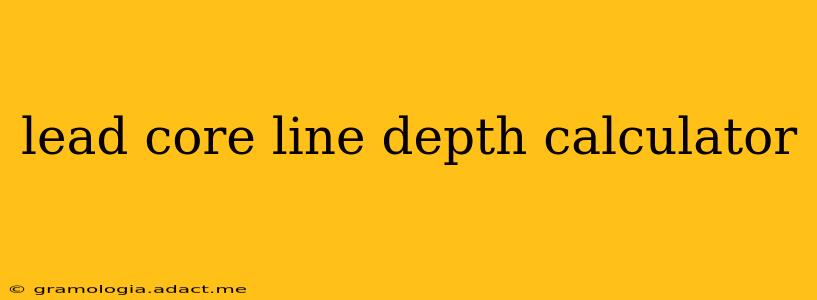Knowing the depth of your lead core line is crucial for successful fishing, particularly in trolling applications. A lead core line, with its braided core and nylon coating, allows you to get your lure down to specific depths without the need for heavy weights that might hinder your lure's action. However, determining the exact depth of your lure can be tricky. This article will guide you through understanding lead core line depth, calculating it effectively, and maximizing your fishing success.
What is Lead Core Line and Why is Depth Important?
Lead core line is a specialized fishing line featuring a braided core of lead wire encased in a nylon coating. The lead core adds weight, allowing you to achieve significant depth without overly cumbersome weights. This is particularly beneficial for trolling, where you need to present your lure at specific depths to target fish holding at different levels in the water column. Understanding the depth of your lure is paramount because different species of fish inhabit different depths, and presenting your lure at the correct depth dramatically increases your chances of a successful catch.
How to Calculate Lead Core Line Depth
There's no single universally accepted formula for calculating lead core line depth. The depth is affected by several factors, making precise calculation challenging. However, we can use a general guideline and understanding of those influencing factors to get a reasonable estimate.
General Rule of Thumb: A common starting point is to assume that lead core line will achieve approximately 1 foot of depth per 10 feet of line out. For example, 100 feet of lead core line out might reach a depth of roughly 10 feet.
Factors Affecting Lead Core Line Depth:
- Line Speed: Faster trolling speeds will generally result in shallower depths for the same amount of line out. Slower speeds allow the line to sink more.
- Line Diameter: Thicker lead core lines will tend to sink more quickly and achieve greater depths than thinner lines.
- Lure Weight: The weight of your lure plays a significant role. A heavier lure will sink faster and reach greater depths than a lighter lure.
- Current: Strong currents can affect the depth of your lure. A current running against your trolling direction can push your lure shallower, while a current running with your trolling direction may push it deeper.
- Rod Angle: The angle of your rod also influences the depth. A lower rod angle will generally result in greater depth.
How to Use a Lead Core Line Depth Calculator (or lack thereof)
Unfortunately, there isn't a readily available, universally accurate "lead core line depth calculator" in the form of a precise online tool or app. The variables mentioned above make the creation of such a precise calculator difficult. The depth is highly dependent on the specific conditions on the water at any given time.
Instead of relying on a specific calculator, focus on understanding the factors above and experimenting to find what works best in your fishing conditions. Keeping a detailed log of your trolling runs – noting line out, speed, lure weight, and observed depth (if possible using a depth finder) – is essential for refining your technique over time.
What are the best depths to troll lead core?
The best depths to troll with lead core depend entirely on the species you are targeting and the lake or body of water you are fishing. There's no universal answer. Consult local fishing reports, guides, or experienced anglers for information specific to your location and target species.
How do you adjust lead core line depth?
You adjust lead core line depth primarily by changing the amount of line let out. You can also adjust your trolling speed (slower speeds typically mean greater depth). Using heavier or lighter lures also impacts depth. Finally, adjusting your rod angle can fine-tune your depth, though this is a less significant factor compared to the others.
How much lead core line do I need?
The amount of lead core line you need depends on the depth you are targeting and the size of your lure. For deeper trolling, you’ll need more line. Start with a sufficient length to reach your desired depth and then adjust based on your experiences.
What is the best lead core line for trolling?
There are many excellent lead core lines on the market, each with varying line strengths and diameters. Choose a line appropriate for the size and type of fish you’re targeting.
By understanding the factors influencing lead core line depth and diligently keeping track of your fishing outings, you can effectively “calculate” the depth through experience and achieve more consistent success in your trolling endeavors. Remember that experimentation and observation are key to mastering lead core fishing.
